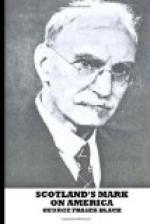SCOTS AS SCIENTISTS
Alexander Wilson (1766-1813), born in Paisley, the first naturalist to study American birds in their native haunts, and author of “American Ornithology” (1803-13), was also distinguished as a poet. David Hosack (1769-1835), one of the most distinguished surgeons and scientists of his day, fourth President of the New York Historical Society, was son of a native of Morayshire. Samuel Guthrie (1782-1848), physician and chemist, was descendant of John Guthrie, who came to America in 1661. He was one of the pioneers who introduced vaccination, produced the first successful percussion powder (after many experiments), invented the “punch lock” which superseded the flint-lock musket, and, in 1831, discovered the anaesthetic chloroform. Hugh Williamson (1735-1819), statesman and scientist, born in Pennsylvania and educated in Edinburgh. He studied theology and was licensed but never preached, was Professor of Mathematics in the College of Philadelphia (1760-63), studied medicine in Edinburgh and Utrecht, practised successfully, served as surgeon in the Revolutionary War, delegate to the Convention that framed the Constitution of the United States (1787), and was afterwards Member of the first Congress. John McLean (1771-1814), born in Glasgow, became Professor of Chemistry in Princeton (1775) and later Professor of Natural Philosophy and Chemistry in William and Mary College, Williamsburg, Virginia. His son, John, became President of Princeton. Dr. William Watson (d. 1828), a Scot, was physician and friend of Chancellor Livingston, and one of the early promoters of scientific agriculture in America. He was founder of the Farmers’ Club of Dutchess and Columbia Counties, the pioneer




